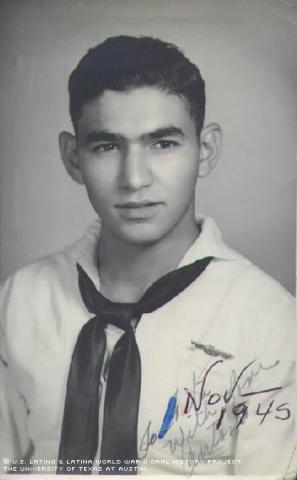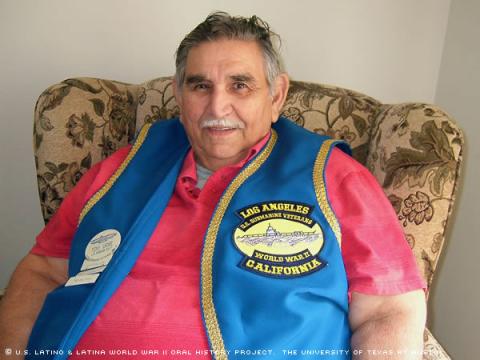

A full moon showering light over Mt. Fuji one night while on lookout duty in Japan is the wartime image Antonio Uribe recalls most vividly as he recounts his humble beginnings in Texas and the world of basic training and nautical knowledge that transformed him from boy to man.
The oldest of five children, Uribe was born to Alfredo Eloy Uribe and Esther Sanchez in San Ygnacio, Texas, on Jan. 13, 1925. When he was five, his family moved to Laredo, about 36 miles north of San Ygnacio, but they never forgot their small-town roots. For instance, they made annual trips back to San Ygnacio to enjoy Catholic Holy Week and its religious festivities.
The war was already under way by the time Uribe was a student at Martin High School in Laredo, and he was enamored with the idea of joining the Navy. Thanks to a chance meeting with a recruiter, his dream would soon materialize.
He’d already registered for the draft when in February of 1943 a recruiter visiting Laredo told Uribe his best chance of serving in the Navy would be to request getting drafted early. So, after receiving his parents’ blessing, Uribe decided to forego his diploma and ventured from Laredo to San Diego, Calif., for boot camp training.
Training was no easy task. Uribe recalls marching with other enlistees under the scorching sun.
“San Diego in the summer – walking on the hot asphalt you get blisters on your feet,” he said.
After completing boot camp, Uribe was selected to receive instruction in flag signaling, Morse code and navigation. In the fall of 1943, he graduated and earned the rank of Seaman 1st Class.
The Navy soon announced it was offering submarine service, but that only five positions were open to Uribe’s class of about thirty students. He decided to volunteer, soon finding himself immersed in submarine training on a Navel Destroyer. When asked why he volunteered to face the dangers of a submarine, Uribe laughed and said, “because I was crazy. … You had to be crazy and you had to be young.”
In March of 1944, having already been promoted to Quartermaster 3rd Class, he was assigned to sub USS Sunfish SS-281. His primary duties were correcting navigation charts and ensuring all the clocks were running on the correct time.
Soon enough, Uribe and his fellow submariners received their orders: Their vessel was to head to Japan; their main objective being to “seek and destroy” Japanese ships. He was a lookout, and would stand on top of the submarine when it cruised the surface, keeping a close eye on the horizon for the appearance of enemy ships or the slight possibility of a periscope of an enemy submarine. His first glimpse of war came when he and another lookout spotted an anchored ship, and after signaling the ship to identify, a Japanese merchant flag was raised. His sub immediately fired two torpedoes and missed; however, a third one hit and sank the Japanese vessel
Uribe’s patrol on the USS Sunfish SS-281 lasted about 45 days. His next official assignment was to run patrols on the USS Pilotfish SS-396, which cruised the Pacific around Japan searching for survivors of planes that had crashed into the sea. The danger faced during these patrols came from both enemy fighter planes and U.S. aircraft. Uribe recalls one incident in which the United States sub in front of his was mistaken for a Japanese vessel, and a U.S. fighter plane dropped several bombs. The sub averted catastrophe only by diving in time to avoid being destroyed.
On August 6, 1945, the U.S. dropped the first atomic bomb on the Japanese city of Hiroshima, and three days later, it dropped a second bomb on the city of Nagasaki. Uribe was on his final patrol at the time and said he believed it to be a standard “bombing raid.” He didn’t become aware of the damage’s extent until his patrol ended.
“I feel the Japanese would not have surrendered and it would have cost very heavy casualties had we invaded Japan,” he said of the bombing in a written account of his service record.
The USS Pilotfish SS-396 was approximately 100 miles from Tokyo Bay when Uribe and his fellow servicemen learned Japan had surrendered. Before heading home, they would participate in a monumental event as they proceeded to enter Tokyo Bay and were anchored alongside the USS Missouri Battleship, where on Sept. 2, 1945, Japan officially surrendered.
According to Brayton Harris’ “The Navy Times Book of Submarines,” U.S. subs played a pivotal role in winning WWII, sinking “1,300 merchant ships, one battleship, eight carriers, eleven cruisers, and 180 smaller warships – including thirty-two submarines.”
He was discharged from the military in December of 1945, and would eventually begin his new life by marrying Josefina Soliz on Nov. 30 1957. Together they shared “47 wonderful years,” said Uribe, their marriage producing two college-educated children and four grandchildren.
When asked how WWII altered his life, Uribe said, “I got to … trust myself more. I feel that I learned how to be someone that I was supposed to be.”
Mr. Uribe was interviewed in Corona, California, on June 1, 2007, by Maggie Rivas-Rodriguez and Henry Mendoza.

